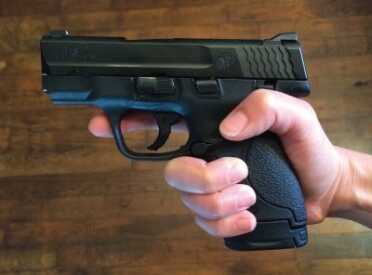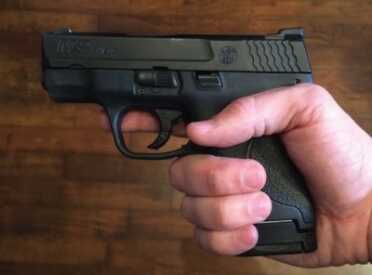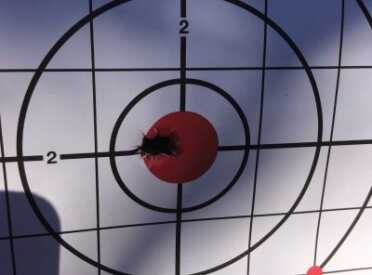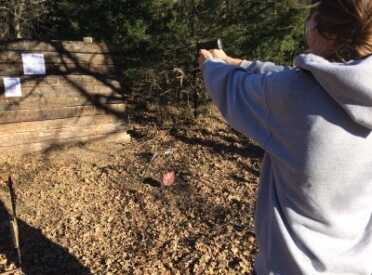
Ana’s gun — the Smith & Wesson M&P Shield in 9mm — is a great combination of size, ergonomics, and stopping power. It’s slightly larger than other single stack handguns, which helps a small-handed shooter handle recoil. But it’s also small enough to easily conceal, and the ergonomics and shootability are excellent.
In Parts I and II of this series, Ana and I discussed how to help your wife or girlfriend purchase her first concealed carry handgun. Now that she’s made her decision and bought her firearm, it’s time for the final step: the range.
- Help Your Wife Purchase a Concealed Carry Firearm, Part 1: The Talk
- Help Your Wife Purchase a Concealed Carry Firearm, Part 2: The Search
- Help Your Wife Purchase a Concealed Carry Firearm, Part 3: The Range
Carrying a handgun won’t do your girlfriend much good if she can’t use it effectively. She doesn’t have to be Jerry Miculek, but she does have to be good enough to put shots on target, under pressure, out to about seven yards.
Towards that end, it’s important that she get out to the range on a regular basis. But if your wife is anything like Ana, she doesn’t see the range as the most enjoyable place to spend a Saturday afternoon.
“Growing up, trips to the range were more of a frustration than anything else,” she told me. “I know I need to practice, but sometimes it’s hard to prioritize range time over the million other things I have to do.”
I don’t think Ana and I are alone in this regard. Regular dates to the range are among my fondest dreams, but Ana isn’t quite as enthusiastic.

I liked shooting Ana’s so much that I decided to get one too. Mine has night sights and no external safety, which I prefer on my carry guns.
So, in this final installment, I want to cover a few strategies for helping your wife or girlfriend develop her handgun skills—and have fun in the process. As you’ve probably gathered, I’m gearing this advice towards firearms newbies. If your significant other is already kicking your ass at the range, you’ll want to look for more advanced techniques.
Before we dive in, just a quick disclaimer. I’m not a psychologist… or a marriage counselor. If you think teaching your girlfriend to shoot might endanger your relationship, you should probably consider contacting a qualified firearms instructor in your area (more on that in a minute). Remember, this should be fun. If it isn’t, you might be the problem.
Also, if you are a firearms instructor and have experience working with first-time gun owners, please leave a comment below and describe your experience. What worked? What didn’t? What kinds of drills and advice seemed especially helpful? We’d love to hear from you.
Where and When to Shoot?
First, remember that public ranges can intimidate new shooters, even if they’re accompanied by an experienced instructor. Private land is always the best place to teach someone to shoot. There’s no extra noise, no ranger officers, and no one to offer that oh-so-helpful unsolicited shooting advice.
If you don’t have access to private land, try to pick a time when you know the range won’t be too busy. Most ranger-goers are friendly and sympathetic to new shooters, but the fewer people watching, the more comfortable your wife or girlfriend will be.
Baby Steps
Learning a new skill always entails a certain amount of frustration, but there are ways to encourage a new shooter even as they’re struggling to put shots on target. One of those ways is to make the targets larger. Seeing holes in paper or hearing the ring of a steel target can be encouraging even if the hits aren’t dead center. Conversely, there’s nothing more discouraging than firing a round and not knowing where it landed.
Ana and I started shooting at a large paper target (12×12”) from three to five yards. With a little advice on grip and stance, she was hitting the paper every time.
The goal here is to make it easy for her to succeed. Help her build some confidence. You can start working on more challenging drills later. Right now she needs to know that pulling the trigger can land a shot more or less where she wants it to go.
Simple Drills
The more comfortable she gets, the more her accuracy will improve. As long as she has the correct fundamentals (firm grip, solid stance, smooth trigger pull), it won’t be long before you can start having fun.
We practiced three drills during our first range session. None of them were complicated, but they added a layer of interest beyond a simple target.
The first was the classic 5x5x5x5 (leftmost target in the picture). The goal is to land five shots within a five-inch circle from five yards in five seconds. We nixed the time requirement, as that turned out to be a bit too difficult. Ana was able to land three or four shots within the circle at the beginning, and all five by the end of the session.
Next, we tried a simulated index card drill (bottom target in the picture). The goal was the same—land five shots within the target—but the target page shrunk the “index cards” to simulate shooting at different distances. Ana shot all the targets at three yards, but she was able to simulate five-yard and seven-yard distances by shooting at the smaller targets.
Finally, Ana tried her hand at some controlled quick fire. We simply stapled a regular sheet of printer paper to the backstop, and Ana tried to land six shots in a row as quickly as she could from five yards away. Many of her shots hit low and to the left, which told me she was probably jerking the trigger.
“Trigger jerk” occurs when the shooter can’t pull the trigger without moving the sights. There are a number of ways to address this issue, but the most effective is…
Dry Fire
…dry fire. Dry fire allows a shooter to practice a smooth trigger pull without the surprise or intimidation of an actual gunshot. It’s helpful for all shooters, but it’s especially useful for new shooters who still aren’t acclimated to the noise and recoil of live rounds. Dry firing teaches a shooter that she can pull straight back and through a shot without flinching or jerking the trigger.
We usually practice by aiming at light switches, doorknobs, or any other smallish point of aim around our house. Most modern centerfire pistols can be dry fired without damaging the firing pin, but we use snap caps just to make things more realistic.
Practice on the Cheap
There’s no way around it: counting admission fees, range sessions with 9mm can cost upwards of $80 a throw. If we go every weekend (like we should), we’re spending enough money each month to make another car payment. I don’t even want to think about how much we spend on range time every year.
One way to make practice cheaper is by using .22 caliber ammo or air guns. Many companies make kits that convert your 9mm into a .22, which can significantly reduce your ammo budget. But even if you can’t find your exact gun in a .22, practicing with any compact or subcompact handgun will improve your accuracy and gun handling.
The same goes for air guns. Some companies make air gun replicas of popular handguns, which you can use in your garage or basement. This allows a shooter to acclimate herself to her firearm’s control and practice marksmanship for a fraction of the cost.
Obviously, your significant other should still practice with the handgun she’ll be using for self-defense. But training with smaller caliber firearms can be incredibly useful, both in terms of money and in terms of reduced recoil and noise.
Additional Training?
In a word, yes.
Plinking at the range is great, but nothing beats professional instruction tailored to your wife or girlfriend’s specific needs. You can give her the basics, but only a handgun training class can give her everything she’ll need to survive a self-defense shooting. Classes can be expensive, but it can also be a great opportunity for you both to learn something new.
If you don’t have the funds at the moment, many reputable firearms instructors have produced training DVDs that can also be helpful.
Conclusion
I hope reading about our experience has been useful and instructive. Again, if you have anything to add, please feel free to comment below. I hope these articles, combined with your comments, can provide a useful resource for anyone looking to help their wife or girlfriend purchase, carry and shoot their first concealed handgun.
Click on this link to start Shopping on GunsAmerica
***
About the Author: Jordan Michaels is a new convert to the gun world. A Canadian immigrant to the United States, he recently became an American citizen and is happily enjoying his newly-acquired Second Amendment freedoms. He’s a communications professional, a political junkie, and an avid basketball fan.




A couple of things I found to make target time more enjoyable:
1. Keep the time spent at the range short. I can get agreement to go shoot 20 rounds out of her 5 shot .38 special than I can by planning a couple of hours. Let the first cylinder be just shooting, no guidance, no nothing. Use colored paper, large targets and/or metal targets so she can see or hear her successes.
2. Pick one thing to do..slow, steady trigger pull..double taps..quick first shot…don’t try to do too much at one time.
3. My wife uses conceal carry purses…practice with those.
4. Explain why you are training her, help her to understand that this is part of a man to protect his wife. We all have that instinct to provide and protect, help her realize this is how you can do that.
5. Take along the “fun gun”… Nothing makes wife happier than to rack off a mag from the .223, let her shoot exploding targets, something that is fun for her not you.
Finally, dry fire practice. The best guidance for this is if you can pull the trigger without moving the gun, you will hit what you are aiming at. Whether you pull, jerk or whatever, just don’t move the gun. Laser sights help greatly with this, but you can put an empty shell balanced on the gun…you want to pull the trigger without the shell falling off. You can also observe what the gun is doing…shaking, dropping, moving side to side….better when that empty shell is balanced on the gun and adjust yourself so you can pull the trigger without moving the gun. And again, keep this short. Practice drawing and firing….but do it slow….remember, slow is fast; once you develop the muscle memory of going through the process (and you can pick up on stuff you don’t need to be doing), making practice perfect practice.
And lastly but most importantly, love her. Respect the days when she thinks practice is stupid, offer great amounts of patience and tell her how proud you are, even when practice don’t go so great.
God Bless, stay prayed, stay armed and stay aware
I enjoyed this series and wish I could have read it when I was 17 and started dating the girl I’d eventually marry at 21, lol. We’re still together 37 years later, although I made every mistake you listed and more. We raised two daughters, so I had additional chances to do this process well…or not. Back then it wasn’t yet about concealed carry–it was trying to find a “house and/or car gun.”
Some highlights, lowlights, observations:
1. She grew up with a Dad who was an avid shooter, and she was set in her shooting ways when we married! She had an unshakable preference for a small-frame revolver, isosceles 2-handed stance, complete with left thumb firmly crossed over behind the hammer. She gamely tried autos I brought home, but that muscle-memory left thumb position mandated a revolver.
2. My gee-whiz gun knowledge was a pastime she unwaveringly supported, but never shared. She wanted a smallish revolver, and a few years ago a Model 30-1 J frame S&W snub .32 met with great favor, especially with a lighter Wolff spring for the rebound slide. The original Charter Arms .38 Special we’d bought on a newlywed budget was almost perfect. A Colt D-frame Detective Special was a favorite: slightly heavier, it dampened recoil, plus it was slicker and nicer. She operated them safely, confidently, proficiently; standard-pressure, low-flash, lead bullet ammo was her comfort level; “minute of bad guy” accuracy out to 7-10 yards.
3. Almost everything I ever tried to teach her as an “improvement” was declined, lol. I made that process harder than it should have been, as my strong hobby interests always had new guns coming and going!
4. After almost 30 years of marriage, I managed to introduce one tweak that “broke the code” and worked for all four of us. An experienced reloader by then, I wasn’t limited by off-the-shelf ammo availability. We wanted something bigger than the .32, but no bigger than a J frame Smith .38 Special or the Colt Detective Special. It was legal to carry in the car and have at home, and concealed carry was now another option. How could I get a 2″ .38 for car and occasional carry, and a 4″ gun that was exactly the same action, ammo, everything–just with a longer tube for house duty? I didn’t want to spend the fortune necessary to come up with scarce 4-5″ barreled J frame .38’s to match the snubs for all three of my girls. They all preferred the Smith & Wesson style cylinder latch vs. the Colt.
5. “The Elusive Answer”: caliber .38 S&W (NOT Special) Model 32-1 round-butt 2″ and its square butt, 4″ big brother, the Model 33-1. Weight: about 21-22 oz. loaded. (Slightly less with my older, collectible, more compact I and Improved I frames, out of production since 1950’s.) I could get into those models relatively inexpensively via online auction sites. Had the option of snappier Buffalo Bore 125g LSWC at true 990 4″/875 2″ barrel vels, or my own handloads. (I know the handload argument well, and will just say that in my part of Louisiana, no jury would worry that a 140-148g lead bullet at 700-800 fps is some sort of evil death ray. Different situation in some other parts of the country, I realize.)
6. The guns are loaded with wadcutters at higher velocity than .38 Specials with target wadcutter 650-700 fps ammo, and likewise stronger and more efficient than the typically weak, minimally available commercial .38 S&W 145-46g LRN at 600-700. Have had speedloaders and strips filled with a long, pointy 200g bullet that penetrates, then tumbles, with great sectional density carrying it through 5-6 water jugs, blowing up a couple en route. Just got a 150g LFN mold with long ogive, designed by Outpost75 to replicate the old .38 Colt New Police loads that were factory-loaded between 680-770 fps. Subsonic vel avoids the muzzle blast effect that makes my ladies uncomfortable. Will provide them that 150g for their speedloaders now, as power level and POI match the wadcutters carried in the guns. Shorter, rimmed cartridge case allows fully reliable full-length ejection.
7. End state: all four of us have matching sets of 2″ and 4″ .38 S&W steel, solid-frame, swing-out cylinder, full-length ejection guns loaded to low-end .38 Special standard pressure power levels, with more efficient defensive bullets for both carry and reload. The guns were 90-100% condition because that old caliber was typically a sock drawer or nightstand gun, and S&W made them up to 1974. So: high quality guns, complete interoperability, perfect fit to hand and strength, 19-21 oz. weight is almost perfect balance; power level is in their comfort zone and superior to .22, .25, .32, .380. (My personal carry 4″ guns are loaded with 150g LHPs at 825, expand to .61″, and penetrate into jug #4; snubs carry 200g LSWC with .30″ meplats, good crush cavity to jug 5 or 6, blowing up #1 and/or 2.) Everybody can torso-sized targets at 7 yards with 5 shots in 5-7 seconds. Trigger length of pull, weight, and ammo power all match relatively weak hands and lack of interest in learning an auto’s mechanism, malfunction drills, dealing with muzzle flip, and inadaptability to their preferred left thumb position.
8. Husband/dad (me) as trainer was a VERY hit or miss proposition! Fit, good power ratio to gun weight, weight and length of trigger pull, low muzzle blast, was an elusive goal! They did not like heavy guns or snappy blowbacks either. Low hand strength practically eliminated slide racking. Simplicity of revolver fit their purposes: self- and home-defense capability.
9. No gun/ammo combination currently manufactured really fits these roles. Too bad, as today’s 15-16 (or even 12) ounce .38 Specials commonly generate a bit more recoil and blast than many shooters want, and cause the unwary problems with full-length ejection. Or, they employ weak and/or inefficient target loadings, with cylinders unnecessarily long and heavy.
10. The ideal modern equivalent of my I frames would be the Taurus .380 revolver, chambered for the rimmed .38 S&W cartridge, using Buffalo Bore ammo. A 3″ barrel would be most flexible for carry, car, home; or just make 2″ and 4″ models. Also need more manufacturers to load appropriately-designed flatnosed or hollowpoint lead bullet in their .38 S&W ammo, replacing the obsolete LRN.
11. An even easier solution: use the old ** .38 Short Colt ** cartridge loaded with hard 125g flatpoint and soft, gas-checked, non-leading SWCHP bullets at 825-850 fps. This cartridge has three longer-cased brothers: .38 Long Colt, .38 Special, .357 Magnum, so it could be used in such guns if desired, plus manufactured with existing equipment. Keys: I or J frame size, shorter cylinder, shorter cartridge. Compact, simple, light, full-length ejection, leveraging modern metallurgy and ammunition technology, much more modest flash & blast & pressure than currently popular J frame .38 Specials with jacketed JHP bullets, and more powerful than any small-caliber autos. Load to +P levels or with modern non-canister powders to 1000 fps for those so inclined. I have successfully duplicated the .38 Special Speer GDHP 135g bullet at true 860 fps, the bullet’s design velocity, in steel-framed .38 S&W 4″ guns. To safely get this performance from a 2″ barrel, use a gas-checked LHP bullet or non-canister powders.
Another good choice for a concealable 9mm with some recoil-dampening weight is the Kahr series of pistols – the K9 and P9 being great options given the grip length and Shootability. They have a low bore axis and the K9’s rubber grips really work well.
As an instructor both at the professional and beginner levels, I can tell you from experience that teaching a sigificant other to shoot rarely has positive results. Many hobbyist shooters don’t realize the deficiencies in their own shooting because they rarely shoot with an “Accountability Partner.” Someone who is good enough to critique and interested enough to do so thoroughly and objectively. So you could be passing along your own bad habits without even realizing it. Do YOU get good hits because you are just that good, or because you’ve found sufficient coping skills to get you through a pet drill? As a professional Firearms and Use of Force instructor, I rarely coach my own wife and I don’t teach her new skills. That I leave to a trusted, competent surrogate.
My wife does like to shoot but maybe not as much as I do. Because of arthritis in her hands she has a problem with working the mechanism on pistols. She has no problem with revolvers and practices with a WW2 32 her father had and my nine shot 22 revolver. We will be shopping for a easily concealed revolver. I’d like for her to carry something more than the 32. I’m thinking of a 38 special. My 9mm Beretta serves me well. Another advantage for her with a revolver besides no slide to work is the simple pull, aim, shoot feature. Any suggestion.
Eighty bucks a pop at the range, enough to make a car payment every month if you go once a week? My God, where do you live? My range costs run me $50.00 for a yearly membership & the only extra cost is a buck per silhouette target & I can shoot every day if I want. Granted, the local range is not much & is located on a local law enforcement officer’s ranch land but still…
I’ve had several new shooters up from Metro areas that have not had a single member of their family that had any connection to a firearm, in three generations! Not a Grampa with a farm, not an Uncle who bird hunts. Nada.
Couple of things I’ve learned-
1)Start real slow. Many brains seize when there’s a first gun in the hand. No matter how empty. They can only think OMG this a GUN! The Devil’s tool my Mama warned me about. Little else registers. Panic is gaining a beachhead.
So I start with an orange dummy gun. Get their hands on it, practice muzzle control, hand it back and forth safely, walk thru the house with, pick it up set it down. Discuss relativity of “safe” muzzle direction, importance of trigger finger on frame. Get them used to handling it. Then work on fine points of grip, find them a comfortable but stable shooting position, etc. When thoroughly relaxed with this, I add an empty airsoft replica and do trigger pull. After 50 or so I add CO2 we do trigger pull with report. Then on to a real gun for more trigger pull, loading and unloading, etc. Always with an eye on safe handling and resect for the gun. Only progressing as each step is assimilated and integrated.
2) Delay adding in any sighting and aiming as long as possible. There is no factor that will screw up a smooth, confident, shot as much as aiming. Have the mechanics well dialed in so there is nothing else for them to think about.. Trigger pull trigger pull trigger pull. First gas only airsof, then pellet firing airsoft, then dry firing a real firearm, loading and unloading, then actual live fire. BUT NO SIGHTS.
Only when they’re a well oiled machine at handling the gun, presenting the gun, stroking the trigger, and handling the report and recoil, do I add in the various means of indexing the gun to actually strike a target. Even then I start with just using the top of the slide to index and hit a larger target (a full size B-27 at this point) at 3-5 yards.
Early success, and a relaxed, confident and attentive student, is pretty much guaranteed at this point.